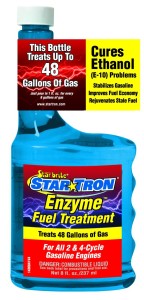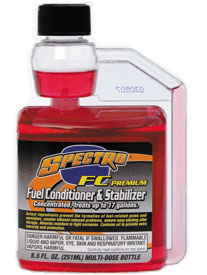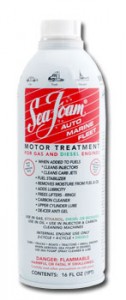
Rust never sleeps, and gasoline doesn’t keep. Do any of your motorcycles–or car, lawnmower, boat, etc.–sit for more than a couple weeks between uses? The best advice I can offer is…don’t let them. Running your vehicles every week–or two maximum–until fully warm is the best way to prevent fuel delivery problems with contemporary gasoline. When you can’t run them, here’s what I do to minimize problems with my small collection of bikes, and my generator, string trimmer and lawnmower, even spare fuel in cans.
 Half Full, Half Empty
Half Full, Half Empty
On carbureted bikes with steel gas tanks, half the fuel system should be drained, and the other half kept full. Carburetors and their tiny air passages and jets can become plugged with aged fuel that deteriorates into sticky varnish over time. Since carb internals are made of non-ferrous aluminum, brass, plastic and rubber that won’t rust, if it’s practical to drain them (shut off the gas manually first or look for a vacuum-operated-type petcock that is off whenever the bike is), this is your best bet for trouble-free operation when refilled. Most carburetors have drains in the bottom of their float bowls operated by turning a screw. Don’t overtighten that screw, and only drain carburetors (into something please, not just onto the bike and floor) when the bike is off and cold, then run the bike until it dies to suck the rest out. I once bought a Honda multi that had been stored in a basement for 15 years with the carbs drained and stabilized fuel kept in the tank, and it was rust-free and fired right up without carb service. If you’re clean and careful, there’s no reason you can’t return the drained fuel to the tank.
On the other hand, steel tanks on carbureted or fuel-injected bikes can rust inside, so it’s best to leave them at least 3/4 full of fuel to which you have added fuel stabilizer (more on this later). Some newer models have plastic-shrouded aluminum or plastic tanks, in which case it’s up to you, but make sure you stabilize it if you leave fuel in the tank. In really humid environments I would still keep an aluminum tank full.
Fuel injection systems seem much less susceptible to the ravages of stale fuel, and once full of stabilized fuel are almost care-free. In fact, some manufacturers warn against running their EFI bikes entirely out of fuel.
If you can’t drain carbs, after adding stabilizer to the fuel in the tank run the bike long enough to insure stabilized fuel has filled them, then shut off the bike and petcock. I carry a small bottle of stabilizer with me when I take out one of my less frequently ridden bikes, and add it at the gas station before riding home. Err on the side of adding more stabilizer; you can’t overdose (within reason) with the products I mention below. Stabilized fuel in the carbs does not guarantee that they won’t suffer from plugged passages or jets, however, and you should still run bikes kept this way at least every three weeks. More often is simple insurance that you won’t need an expensive carburetor overhaul–just make sure you run the engine until it’s fully warm (to burn off water and contaminants in the oil and exhaust). While you’re at it, pump the fork and shocks and work the brakes, clutch and shifter to keep seals flexible and lubricated.
 A Stable Relationship
A Stable Relationship
Your best friend and ally in the fight against bad gas and fuel delivery issues is fuel stabilizer. Three we’ve found to provide consistent and reliable results with motorcycles are Seafoam Fuel Additive, Spectro FC Premium Fuel Conditioner & Stabilizer, and Star Tron Star brite Enzyme Fuel Treatment. There are others, but we lean toward these simply because they include motorcycles in their literature and FAQs and that gives us a warm, fuzzy feeling. All make lots of claims about their effectiveness that we have no way of proving or disproving, so just buy some and use it, or spend hours online researching them before you just buy some and use it. Spectro and Star Tron both offer smaller bottles and/or with measuring devices built-in to make carrying and using it while out on the bike easier.
 The instructions for each will tell you how much to use, how long the fuel is usable when treated, etc. There are some consistent rules of thumb. You generally only need to stabilize fuel if you won’t use it up within two months (but carbureted bikes should still be run every couple of weeks as described above). Adding a little new gas or stabilizer to old gas won’t renew it, nor will adding more stabilizer to old stabilized gas extend its usable life. Overdosing is not an issue (unless you drink it, duh), and in my experience none of them will cure a plugged-up carb no matter how much you add to the fuel. Your best bet is to avoid plugging it in the first place.
The instructions for each will tell you how much to use, how long the fuel is usable when treated, etc. There are some consistent rules of thumb. You generally only need to stabilize fuel if you won’t use it up within two months (but carbureted bikes should still be run every couple of weeks as described above). Adding a little new gas or stabilizer to old gas won’t renew it, nor will adding more stabilizer to old stabilized gas extend its usable life. Overdosing is not an issue (unless you drink it, duh), and in my experience none of them will cure a plugged-up carb no matter how much you add to the fuel. Your best bet is to avoid plugging it in the first place.
Tuttle Out.
For more information:
spectro-oils.com
starbrite.com
seafoamsales.com








Good advice, especially in this day and age of ethanol based fuels. I am fortunate where I live to be able to still buy non ethanol fuel, but I still add a quality additive before storing any of my bikes or equipment. Let’s hope the new administration makes the EPA back off of their Renewable Fuels mandate and let’s also hope that non ethanol fuels remain an option for those of us who try to avoid E-10, and especially, E-15.
Thanks for good and clear usable info that is not overly crowded with pop-ups and other crap that is a discrediting the value of your content.
Thanks Pete
Appreciate the article. Very informative.
Check Seafoam’s MSDS, it clearly staes that Seafoam is 25% alcohol. That’s one of the things we are trying to eliminate in our gas and gas treatments.
I was told by a motorcycle mechanic that has been in business for over 45 years that Marvel Mystery Oil is what he uses. He went on to explain that 2 stroke motorcycles almost never have fuel related problems and thats because it has oil in it that the oil coats the fuel system and protects from corrosion and rust. MMO is an oil based fuel system treatment and if at proper dilution it too coats the system as well as cleans not only the fuel system but also lubricates the upper cylinders and valves. Plus MMO has been tried and trued since the 1920`s….thats what I use. Right before I store my bike I pour in 2 oz.`s then fill and ride for a little while to get it all worked in before storing my bike. I have stored it for 4 full months on several occasions and have never had an issue.
I put stabilizer in a tank full of fresh gas but to cold to start bike to get in carbs what should I do
Quick question… I have a small fleet of 8 scooters that I rent out in the summer. They are 2015 Yamaha Vino 50cc models. This year I am storing them about a 10 minute drive from where I rent them. Should I be putting the stabilizer in and then driving for 10 minutes to the storage area (to run it through the system) OR should I wait until I get to the storage area, and just run the bike stationary for one minute? Suggestions? (Last time I did the latter as I wasn’t really moving them from one spot to another…).
I would think running it through the whole system by taking it for a ride would be better. I’ve been suggested to run my scoot at full throttle (haha, no, not on the city streets with a 400cc) to get a carb cleaner to work its way through the fuel system
If you do so testing on your own you’ll find that most fuel additives for ethanol fuel that claim to prevent rust and corrosion do exactly opposite in long term cold climate storage. Seafoam being the worst. Don’t believe me, try it. Spend some $ , buy the top promoted additives. Seafoam ,stp etc. Pour some ethanol 10 in jars. Add some additive. Let it sit and watch the water accumulate on top of the fuel. A lot of water. Then let it sit further and when the water becomes heavy enough it sinks to the bottom. Now think what is the first thing drawn into your fuel system first time you try to start it. Go further and add antioxidants to the fuel and add a piece of steel. Subject the fuel to below freezing temps for a while then remove the steel and note the corrosion. Seafoam additive had the worst corrosion with stp in a close second place.